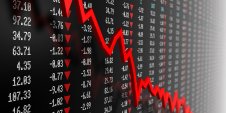 Stocks Decline 14% (June 1950 to July 1950) North Korean troops attack along the South Korean border. The U.N. Security Council condemns North Korea. The U.S. gets involved.
Stocks Decline 14% (June 1950 to July 1950) North Korean troops attack along the South Korean border. The U.N. Security Council condemns North Korea. The U.S. gets involved. - Stocks Decline 20.7%, (July 1957 to October 1957) The Suez Canal crisis manifests itself, the Soviets launch Sputnik and the U.S. slips into recession.
- Stocks Decline 26.4% (January 1962 to June 1962) Stocks plunge after a decade of solid economic growth and market boom, the first “bubble” environment since 1929.
- Stocks Decline 22.2% (February 1966 to October 1966) The Vietnam War and Great Society social programs push government spending up 45% in five years. Inflation takes off.
- Stocks Decline 36.1 % (November 1968 to May 1970) Inflation really starts to pick up, hitting 6.2% in 1969 up from an average of 1.6% over the previous eight years. Vietnam War escalates. Interest rates surge; 10-year Treasury rates rise from 4.7% to nearly 8%.
- Stocks Decline 48% (April 1973 to October 1974) Inflation breaks double-digits for the first time in three decades. There is the start of a deep recession; unemployment hits 9%.
- Stocks Decline 19.4% (September 1976 to March 1978) The economy stagnates. High inflation. Adjusted for inflation, corporate profits haven’t grown for eight years.
- Stocks Decline 17.1% (February 1980 to March 1980) Interest rates approach 20%, the Read the rest of this entry »
 Stocks Decline 14% (June 1950 to July 1950) North Korean troops attack along the South Korean border. The U.N. Security Council condemns North Korea. The U.S. gets involved.
Stocks Decline 14% (June 1950 to July 1950) North Korean troops attack along the South Korean border. The U.N. Security Council condemns North Korea. The U.S. gets involved. 